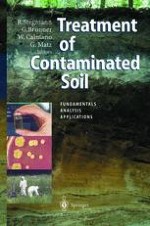2001 | OriginalPaper | Chapter
An Overview of Soil and Sediment Treatment Research in the Netherlands
Author : W. H. Rulkens
Published in: Treatment of Contaminated Soil
Publisher: Springer Berlin Heidelberg
Included in: Professional Book Archive
Activate our intelligent search to find suitable subject content or patents.
Select sections of text to find matching patents with Artificial Intelligence. powered by
Select sections of text to find additional relevant content using AI-assisted search. powered by
Soil and sediment pollution is a serious environmental problem in The Nether?lands. Over the past 10 to 15 years, awareness of the problem, and the policy and strategy to tackle the problem have radically changed. Initially the approach to tackle the problem of polluted soils was primarily focused on the clean-up of soil after excavation. This approach was consistent with government policy of that time, whose aim was the maintenance or restoration of soil multifunctionality. The result was the development and application of intensive and relatively expensive methods such as thermal treatment and soil washing/wet classification, that were capable of achieving the target values set for clean soil. At that time biological treatment methods and in-situ treatment were not considered feasible. However, inventories revealed that the polluted sites in The Netherlands numbered approxi?mately 100,000 and contained more than 200 million tons of contaminated soil. Moreover, the problems associated with cleaning up these sites were found to be highly diverse. It became clear that for both technical and financial reasons, it would be impossible to clean up all these sites to the target values. This realisation resulted in a shift in policy. Rather than try to clean-up all sites completely, the approach shifted to reducing the risk to humans and the ecosystem. Due to this shift in policy, other techniques which were not able to clean-up the soil to the target values were becoming important for practical application. The result was, among other things, an increasing application of in-situ treatment techniques, biological treatment techniques and isolation methods. However, this approach did not fully solve the problem, mainly due to the high costs. This has recently led to a second shift in soil remediation policy. This second shift has resulted in a remedia?tion approach that now also includes a direct link with the intended use of the remediated site. Also, the financial basis for the remediation activity has been broadened by integration of soil remediation into other social and industrial activi?ties such as building, residing, and rural development. Altering the system of fi?nancing will increase the market dynamics of remediation activities.
